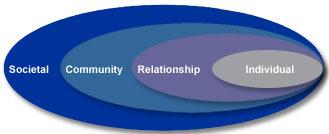Introduction
Social ecology model is a human behavior theory that aims at preventing the eruption of conflicts or violence; the main philosophy advocated by the theory is that violence can be prevented if the underlying factors and forces have been looked into and can be effectively managed. The model uses a four-level social ecological model to understand violence as well as come-up with policies and mechanisms that can be used to solve the violence and of most importance to prevent the occurrence of violence among people and groups. To attain its objective, the model combines four main players of violence among communities that are societal attitudes, community influences, relationships and individuals to manage conflict and violence in communities or work places (Dahlberg, 2002). The diagram below shows the structure of a social ecology model:

The concepts within the model
Within the model, the four corners of considerations work together for the good of the organization; in the case of an individual, the model identifies the biological and socialization attributes that can be used to predict the likelihood of being violent or acting in a violent manner given a certain situation. When focusing on an individual, the main areas to look into are the education level, the income, and any chances of drug abuse, age, attitudes, and the economic situation of the person.
Relationships are another arm of the model, when looking at relationship, the factors to consider include the relationship with peers, intimate partners, and family members, when they are analyzed, there are chances that the chance of violence can be detected and prevention measures put in place. A persons closest peers, members and people around him have a high influence on their behavior and other attributes that might blend to violence.
The third level that should be of importance is the community that a person has been brought up in, in this case community means schools, work places, neighborhoods and the environment surrounding someone. What they believe and do is likely to have an influence on chances that violence might occur in a human life (Gregson, 2001).
The model application and the nursing process
When nurses are operating and offering their services, there is a likelihood that conflict might arise among them, when it arises the delivery of quality and timely services are hampered. When the model is used, nurse leaders will have the chance of understanding the personality, the socialization, attitude and perception that a particular nurse has. When this is understood, the nurse will be able to come-up with such policies that can prevent the occurrence of violence in the team. On the other hand, the nurse leaders can know the best motivational approach they should use with their employees (Rousseau & House, 1994).
Applications of this model to community health problems
When allocating duties, there are some nurses that are rigid to the program, what they would like done is to have the programs set and then they be left to manage themselves. When such a situation is understood, the nurse manager is likely to place such a nurse to program that does not change more frequent, and maybe have another nurse who is flexible to take the flexible duties.
Another example can be when managing young employees who might have just been married or they are at their first births, when making the schedule it is important to consider the flexibility of such people as they have some other tasks that may not be corporate but will lead to low production or violence in the team (Stokols, 1996).
The importance of community partnership in community health projects
When coming up with projects, community health officers and project leaders should involve the communities for the continuity of the programs they are implementing. to start with the community should accept the project; the project should be the priority project of the team and care should be taken to ensure that the community members see the implemented program as the best move that the community health program implementers should have developed (Maurer & Claudia, 2005).
When implementing a project, the community should be there to offer their support; support include information that they give to the project team that is crucial for the attainment of the project objective and goal. Another reason that should make community health projects implementers to involve communities is to ensure that after they have moved from the ground, the project they have left working are well managed and they continue working as they had predicted. For continuity then, the community needs to understand why the project was implemented, as well as how to manage the project (Porche, 2002).
Conclusion
Nurse leaders have the role of developing a winning team of nurses that can offer quality, timely, and affordable services to patients. When building teams, they should consider policies that will prevent conflicts and confusion in the team; such policies include the use of social ecology theory approach.
References
Dahlberg, G.(2002). Violence-a global public health problem. Geneva: World Health Organization.
Gregson, J. (2001). System, environmental, and policy changes: Using the social-ecological model as a framework for evaluating nutrition education and social marketing programs with low-income audiences. Journal of Nutrition Education, 33(1), 4-15.
Maurer, A.,& Claudia M. (2005). Community/public health nursing practice: health for families and populations. Massachusetts: Elsevier Health Sciences
Porche, J. (2002). Public & community health nursing practice: a population-based approach. London: Sage.
Rousseau, D. M., & House, R. J. (1994). Meso organizational behavior: Avoiding three fundamental biases. In C. L. Cooper & D. M. Rousseau (Eds.), Trends in organizational behavior (Vol. 1, pp. 13–30). New York: John Wiley.
Stokols, D. (1996). Translating social ecological theory into guidelines for community health promotion. American Journal of Health Promotion, 10,(1), 282-298.